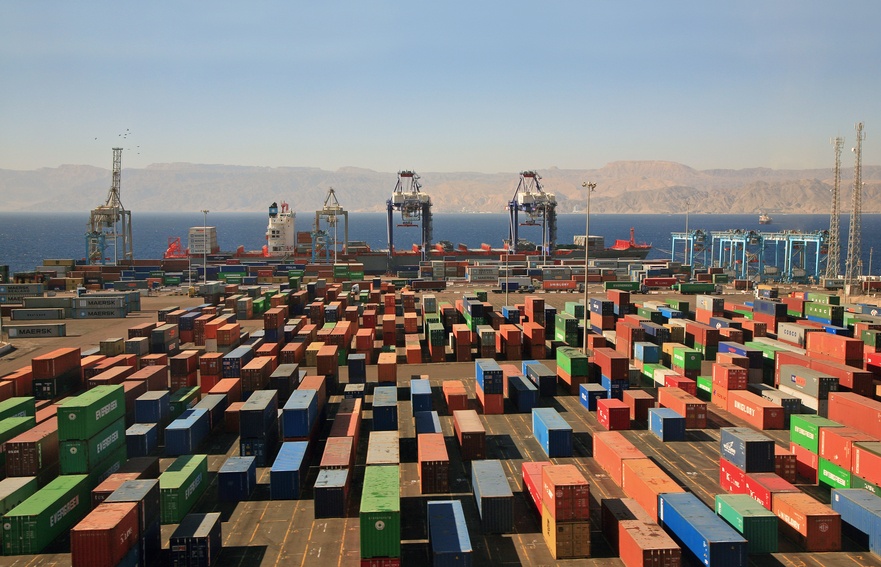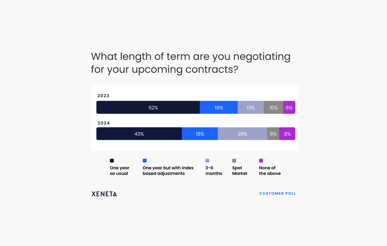- Freight forwarders and shippers/BCOs are on a constant quest to have a better understanding of their ocean freight costs and ultimately have larger margins
- The cheapest quote may not always provide overall cost savings
Both the suppliers and shippers will need to monitor market conditions and costs on an ongoing basis as they enter carrier rate negotiations. For the shipper, in particular, the use of freight cost benchmarking and market movement analytics will also be important to achieve additional insight and a better understanding of overall costs.
Freight costs are considered by many forwarders and shippers to be a major part of their total shipment cost.
Forwarders and shippers are on a constant quest to make sure they are given the best container rates. While many may consider this as the holy grail for shipping and consider it unachievable, with careful planning and using the right shipment methods, lowering your freight costs and making sure they are competitive, can become a reality.
Know Your Destination Market.
Before you ship anything internationally, ensure you understand where your products will end up. You need to know what countries your products will be shipped to, how much those countries cost, and whether any customs fees are involved.
Choose the Right Freight Service Provider.
If you’re shipping goods internationally, you should use a freight service provider (FSP) specializing in international shipments. FSPs typically offer lower rates than traditional carriers because they specialize in international shipping. They also provide more services such as tracking and insurance.
Understand The Importance Of A Global Logistics Network.
An effective global logistics network will allow you to ship products anywhere globally at competitive prices. This means you won’t need to pay high import taxes and duties and won’t have to worry about customs delays. You can also save money by using an FSP with a global reach.
Find Ways to Reduce Transportation Costs.
One of the small businesses most significant challenges when shipping internationally is reducing transportation costs. There are several things you can do to lower these costs. First, consider purchasing items online instead of buying them locally. Second, find out what carrier is best suited for your product. Third, use a trusted third-party provider to handle your shipments. Finally, make sure you’re getting the right insurance coverage.
Learn About Customs Clearances.
If you’re planning to ship products overseas, you must understand how customs clearances work. You also need to know what documentation to provide to customs agents.
Here are 15 tips for lowering ocean freight costs
1. Have a clear understanding of the business
If there is a clear understanding of the business and the processes involved in it, then the costs related to the shipment, who pays what charges and where costs may be saved will become clear.
2. Know the market and the rates that are prevalent
This is a major requirement for the shipper so that they don’t pay more than the market rate to their vendors. Freight cost benchmarking in the market is an efficient method followed by many shippers.
3. Use the right mode of shipment
For example, achieving the best freight rates may be obtained by deciding between Full container (FCL) or LCL or as Groupage
This is because there are multiple charges involved in an LCL or groupage shipment as compared to FCL.
Even within the FCL option, optimization maybe achieved using the right type of container for the right type of cargo – like 20’ container for weight based cargo and 40’container for volume based cargo.
4. Audit your quotations/invoices
Ensure the quotations received from the carriers are correct and tally with your quotation.
There may be cases where the carrier has missed out some shipping surcharges and come to you at a later stage for payment. These could also prove costly for you as you or your customer may not agree to pay additional charges after the business has been concluded.
Auditing your quotation/invoice will help with this issue.
5. Prepare and implement
If your freight procurement is based on a tender, effective preparation and implementation of tender management process is critical as this is one area where you can definitely reduce your freight costs not just related to ocean, but also land-side.
6. Plan effectively
Effective planning coupled with a clear understanding of the scope of business, quantities involved and the frequency of shipments allows you to have efficient freight negotiations with the carriers.
Carriers generally give best value quotations to customers who know what they want and are able to forecast it clearly and this will add to your credibility and reputation with the carrier which is quite important.
7. Triangulation
This is another option which carriers favor and they may offer special deals to customers who are able to triangulate containers.
Triangulation refers to the use of the same container for export and import purpose meaning you export cargo from A to B and also bring back imports from B to A using same container and same carrier.
8. Do not incur unnecessary charges
A lot of times customers incur unnecessary charges either at POL or POD due to demurrage or detention which is mainly caused by improper or timely documentation and in many cases, these charges are so high, the customers may be forced to abandon their cargo.
9. Optimize your route
Route optimization is also another method to lower freight costs. Analyze the routes used by the various carriers/vendors for the delivery of the cargo and satisfy yourself that it is the optimal route for the cargo.
The cheapest quote may not always provide you the overall cost savings that you are trying to achieve.
10. Optimize your cargo packing
Wastage of space can be eliminated by using the right size of cartons, boxes, bags or other packaging material or customizing the same to the size of the container that will be used for the shipment.
Such customized packing also protects cargo from movement during transit and eliminates damages.
11. Know your terms of sale and shipment
This is a crucial factor in achieving cost savings. You as a customer or as a freight forwarder need to know the Incoterms involved, the terms of shipment (CY-CY, CFS-CY etc) and the costs associated with it as these terms help you identify who pays what charges for a shipment and the responsibilities thereof.
12. Don’t classify everything as urgent
Many shippers exhibit this tendency in order to ship/get their cargo delivered at the earliest whether the cargo requires such urgent delivery or not. In a lot of the cases, rush orders incur very heavy costs. Through careful planning and timeline management, these charges may be reduced.
13. Understand your rate
What does your sea freight rate really include? Is the rate port-to-port or door-to-door? Does it incorporate surcharges?
14. Consolidation
Consolidating shipments provides greater flexibility in supply chains and regular, ongoing inventory replenishment. In addition, consolidation supports sustainability efforts. Companies that move goods in fewer, better-targeted shipments shrink their carbon footprint.
15. Communicate and collaborate with your carrier base
Set expectations, share forecasts and other shipment data and look for additional opportunities.
Conclusion
In the quest to get the best freight rates, some shippers and freight forwarders resort to playing hardball with the service providers, which is one of the tactics that can actually hurt carrier rate negotiations. If they are successful, such practices can lead to a reduction in service levels, reliability, fulfillment time from the side of the service provider and may lead to reputation damage for the shipper or freight forwarder.
In today’s business, where everyone is trying to achieve cost savings, it is important to:
- choose the best mode of transportation
- use the right equipment
- consolidate cargo where possible
- automate various processes
- improve supply chain visibility, analyzing the delivery patterns vs costs
Extra Reading: How To Become An Expert In Shipping (Cheat Sheet)
Today’s shipping/freight industry is too complex, too demanding, and too volatile for your people to be casual about whether or not you need new tools and techniques and business roadmaps. How was your last report card? How do you benchmark your results? How do you rank in your particular niche? Management experts are not surprised to see companies that are not at least asking themselves those questions, leave alone finding easy answers, but the do-nothing businesses are losing momentum, fast.
What does it take to get down to business? From MBA classrooms to boardrooms, to mountainside corporate retreats, phrases like “metrics,” and “gold standard” and “benchmarking” continue to bounce off the walls. You can bet that business minds somewhere are, as we speak, convening to thrash out strategies, management techniques, and tools that will keep them getting new customers, keeping valued customers, and standing up to competition. What does any of this talk about “gold standards” and “benchmarking” have to do with your business? Everything.
According to leading consultants, under performers who continue to lag behind in instituting best practices, in reviewing their policies, and in benchmarking their results, are doomed to remain as under performers. The winners, on the other hand, share some common attitudes, tools and techniques.
RELATED INFORMATION
Infographic | 12 Steps to Benchmarking Anything in Your Supply Chain
What’s the secret sauce? We’ve been taking stock of industry overviews and guru-scale advice-makers, and we can condense the takeaways into two fundamentals: Set a gold standard now for management processes. Take a disciplined look at your financials and try to keep those financials flexible.
Let’s see what the two fundamentals are all about:
Set a "Gold Standard" now for management processes
Companies still depending on faxed contracts and handshakes for deals with partners and customers must wake up to the fact that there are new non-negotiables: business processes need to be modernized, standardized, and able to leverage the latest advances in communications software, business intelligence software, and online data services.
Information matters. Good data is your lifeline. The “gold standard” in business practices should translate into a synchronization of information from front to back office. Designated people from selected tiers in the business need access to core parts of the same digital dashboard where they can see the same, constantly updated, picture of how your business is moving from day to day, month to month, quarter to quarter, supported by a database system that promises excellent data integrity.
Getting your arms around a well-managed IT service is a solid step toward becoming a modernized business that can look toward the future with greater confidence. Any company today with no managed IT program or robust filing system is at a clear disadvantage.
Discipline your financials and stay flexible
Cash and good credit go hand-in-hand in order to enter new markets, expand resources, and invest in hiring and staffing professional talent where needed. Out of all your competitors, you keeping a disciplined course can give you the real edge, in being able to go forward with a good credit rating, along with unencumbered assets. While another business may be grinding it out at a break-even point you may step ahead. Experts also encourage taking a rigorous look whenever an investment is under review to make sure there is enough evidence and justification that make it worthwhile.
Actually, the time is now just right because there are so many volatile forces challenging the business—and the time is now because there are so many opportunities to be agile, young in vision and wise in decision making via your own set of best practices.. Navigating through economic and global turmoil, staying on course to market forces, and watching out for the winds of change, will all be far easier when you can draw up your business scorecards and aim high.
%201.png)


-1.jpg)




